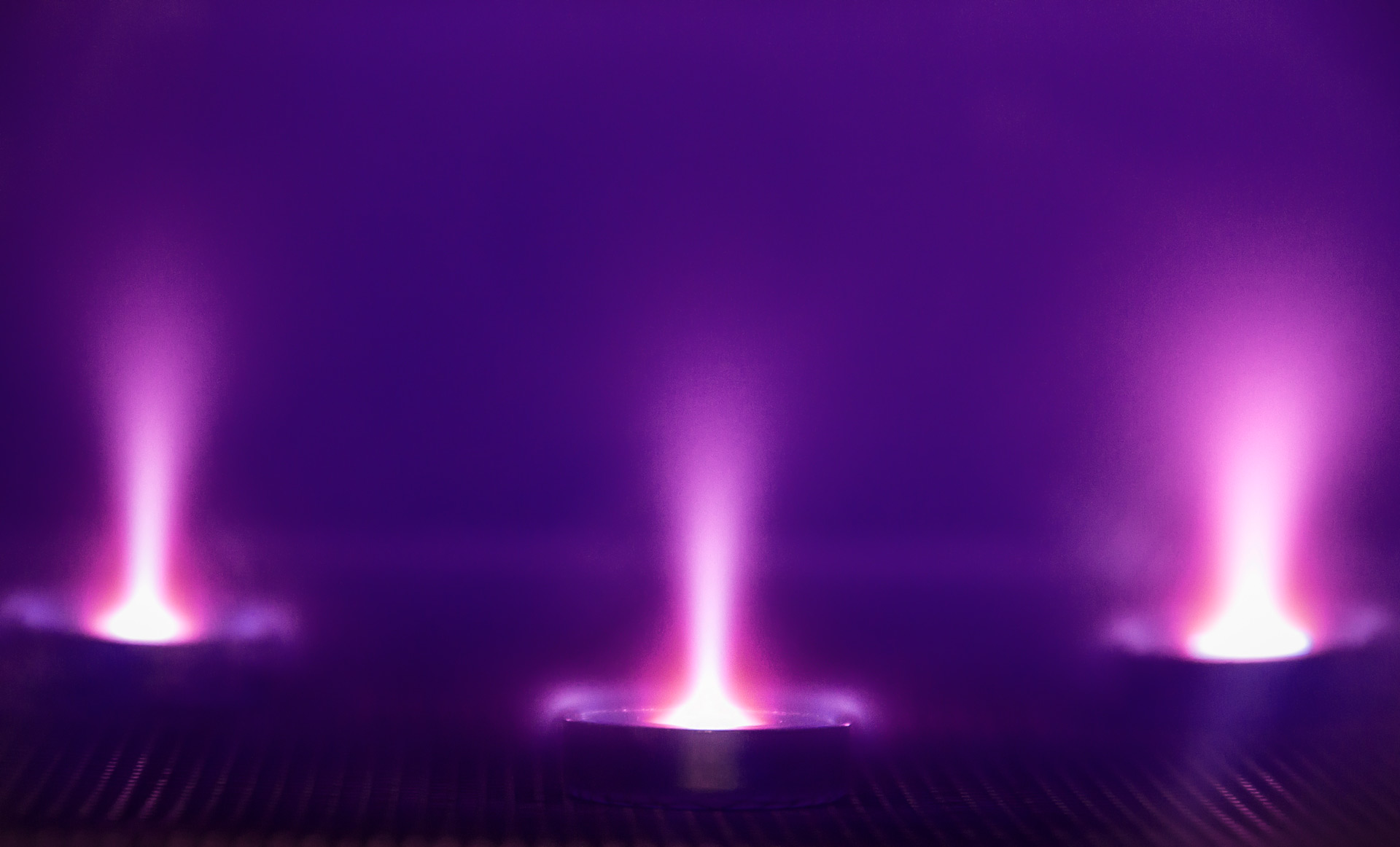
When energy is continuously supplied to a matter, the temperature of the matter increases and it passes from solid state to liquid and finally to gaseous state. If the energy supply continues, the existing atomic shell disintegrates and charged particles are created (negatively charged electrons and positively charged ions). This mixture is referred to as plasma or the "fourth state of matter".
In short: Change of the aggregate state under energy supply: solid ⇒ liquid ⇒ gaseous ⇒ plasma
Natural plasma occurs for example in lightning, polar lights, flames, and the sun. Artificially created plasma is found in neon tubes, welding processes and in flash bulbs, among others.
Plasma is used in applications where it is important to combine materials or to specifically change their surface properties.
Nowadays, plasma technology is established in almost all sectors of industry, and new applications are being developed constantly.
This future-oriented technology allows for modification of a wide range of surfaces. Thus, many different applications are feasible, for example:
In the design of our plasma system, we differentiate between low-pressure and atmospheric plasma systems.
How long can treated (activated) components be stored before further processing?
The storage time of treated components is dependent on activation time and the material and ranges from a few minutes to several months. Therefore, it is often necessary to carry out tests on site.
Metals, ceramics, glass and elastomers: about 1 hour
Plastics (excluding elastomers): several days, weeks, months
How should treated components be stored?
After plasma treatment, it is advisable not to store the parts in the open, as they attract dust, organic contamination and humidity.
Shrink-wrapped components have a substantially longer shelf life than those left in the open.
Components treated by us in the frame of surface treatment services are packaged in close consultation with the customer e.g. certified silicone-free PE bags, ESD packaging, or the customized packaging material provided to us.
Why should the treated parts only be touched with gloves?
Plasma removes organic but not inorganic impurities. As skin contact from the fingers, for example, contaminates the surface with salts (inorganic contaminants), gloves must always be worn when handling components.
How do you measure a plasma activation?
Contact angle/wetting angle
The contact angle is the angle formed by the tangent to the drop contour with the surface of the solid at the three-phase point when observing the projection of the horizontal drop on the solid body. According to the physical definition, a surface having a contact angle of less than 90° is hydrophilic (wettable), whereas if it is (non-wettable). Plasma treatment can the contact angle (increase or reduce it). An appropriate plasma process or application of a suitable coating in a plasma process can turn hydrophilic surfaces into hydrophobic surfaces (also vice versa by hydrophilic layers).
Test inks
Measuring equipment for estimating the surface energy: If the test ink contracts on the surface after application, the surface energy of the solid is smaller than that of the ink; if wetting is retained, the surface energy of the solid is equal to or greater than that of the liquid. By using series of test inks with graduated surface energy , the total surface tension of a solid body can be determined. However, this process cannot be used to determine the polar and non-polar fraction of the surface energy.
Cross-cut test
To test the adhesion of paint coats, a cross-cut test (standards) DIN EN ISO 2409 and ASTM D3369-02) is carried out. After coating, the paint coat on the plastic part is cut in a lattice shape. Then, a standardized adhesive tape is stuck to the cut lattice, pressed on, and abruptly pulled off again. If paint particles are visible on the tape, the adhesion of the coating is insufficient. The cross cut thus shows the bond strength of paint coats on plastic parts.
How do you detect a plasma treatment?
The indicator labels as well as the plasma indicator metal compound show users of plasma systems at a glance whether a plasma treatment has taken place. The tests can be carried out in virtually no time. They can be used in any plasma system for any treatment type, whether cleaning, activating, etching or coating. The indicators detect plasma treatment previously carried out on your products and semi-finished products, even after weeks or months.
Indicator labels
Adhesive labels are made of specifically coated films, which can be placed directly in the chamber or stuck to the component for reference purposes. The disappearance of the dark indicator point shows the successful completion of the plasma treatment. The indicator labels can also be used for a system test: Place a label in the empty vacuum chamber and ignite the plasma.
ADP plasma indicator
The plasma indicators are adhesive labels coated with a special fabric. On successful completion of the plasma process, the fabric will dissolve.
The adhesive label is stuck to a component or dummy which is then exposed to the plasma beam as a reference. The indicator does not in any way affect the actual plasma process or the component. The fabric is destroyed during the treatment.
Plasma indicator metal compound
The plasma indicator is a liquid metal compound which decomposes in plasma, giving the plasma-treated surface a metallic shine. During plasma treatment, a drop applied to the component itself or a reference sample is transformed into a shiny metallic coat providing a strong contract to most surfaces and the originally colourless drops. The shiny golden metal film generated in the plasma is visually distinguished from all the other colours of the object by its reflectivity.










